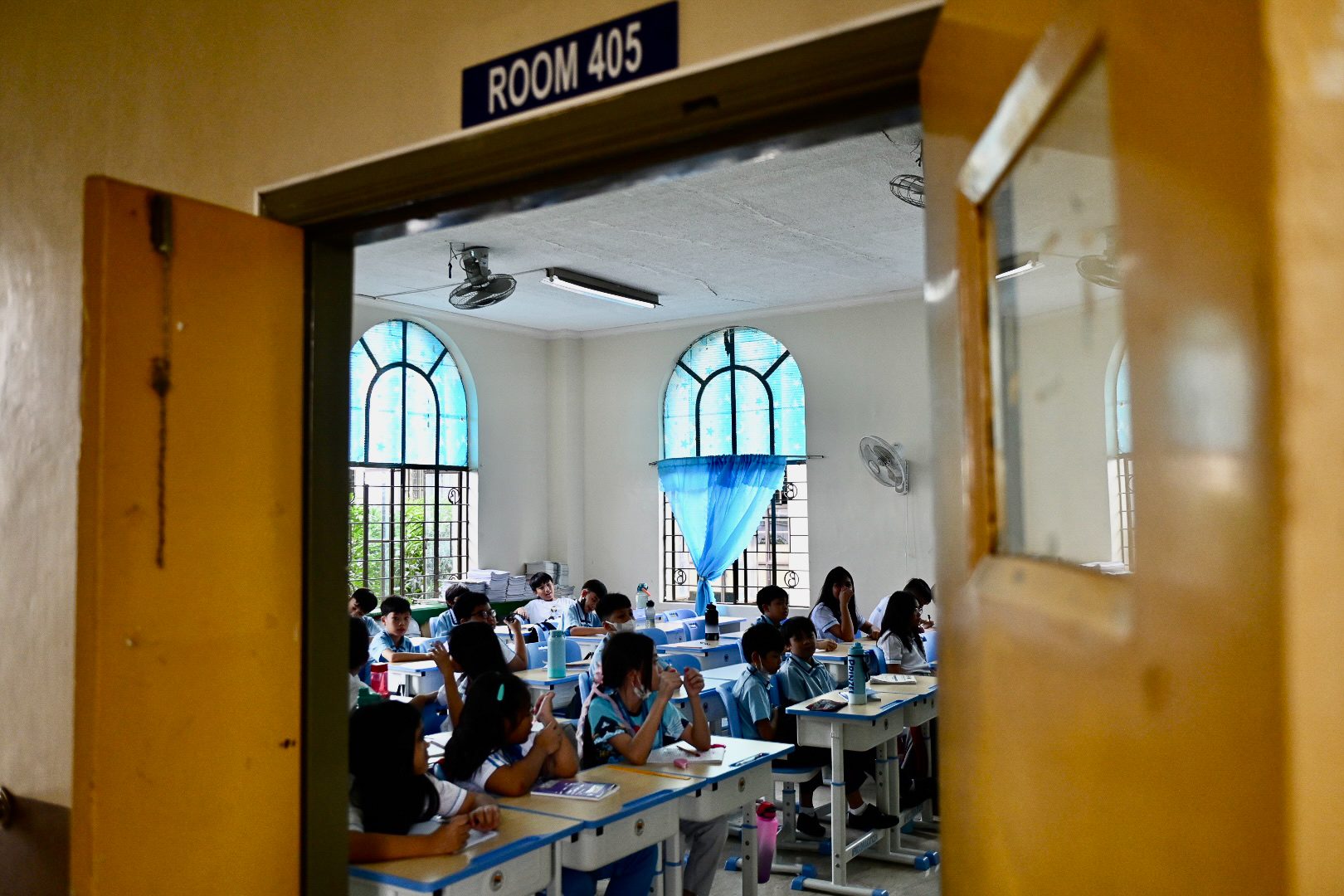SUMMARY
This is AI generated summarization, which may have errors. For context, always refer to the full article.

MANILA, Philippines – The once colorful classroom of Elena del Rosario (not her real name) in a public elementary school in Makati was now bare, the walls stripped of posters and decorations. The only thing left was the tape marks where educational materials and artworks used to be.
This change comes after the Department of Education (DepEd) issued a directive to schools to remove classroom decorations, supposedly to help students concentrate on their lessons.
The memo outlines that schools must maintain cleanliness, keeping school grounds, classrooms, walls, and other facilities free from unnecessary artwork, decorations, tarpaulin, and posters at all times.
“Classroom walls shall remain bare and devoid of posters, decorations or other posted materials. Classrooms should not be used to stockpile materials and should be clear of other unused items or items for disposal,” it added.
The memo also reiterated a 2010 order that prohibits oversized signages with commercial advertisements, words of sponsorships, and/or endorsements or announcements in schools.
Education experts interviewed by Rappler, however, expressed concern about this new directive and its effect on students’ learning environment.

Balancing act
Education professor and clinical psychologist Merimee Tampus-Siena said that while DepEd’s directive is substantiated by some studies, its overall applicability is still uncertain.
“It’s not advisable for them to get bored due to an overly monotonous classroom environment. However, having too many distractions is also not appropriate,” Siena said.
University of Santo Tomas education professor Eleanor Bahrami-Hessari compared a classroom with bare walls to a hospital room. She said the DepEd memo goes against what educators are trained to do, and what educators believe in terms of learning environments.
“Without the learning environment being structured in such a way that it has appropriate materials that will encourage children to learn, there’s something missing in the teaching and learning process,” Bahrami-Hessari said.
Bahrami-Hessari and Siena also recognized the potential of classroom decoration as a tool to reinforce learning.
“Instead of being a distraction, it can actually enhance student learning. There are such truths when it comes to visual aids. There are also such truths when it comes to classroom decoration,” Siena said.
Del Rosario echoed this sentiment, as she emphasized the practicality of certain decorations in aiding students’ learning.
“I’m teaching Grade 2 pupils, and we train them to write in cursive. When I teach them cursive writing, they are not able to immediately copy the proper strokes. They would copy from the poster on the wall, so it helps,” Del Rosario said.
Siena also noted that classroom decorations are important to students since these give them a “sense of ownership and belongingness.”
“When I enter the classroom, I’ll feel like we own this learning environment. We’re a part of this learning environment. And we’re not in a place where I only see four corners and walls,” Siena said.
Classroom shortage
Beyond decoration concerns, Bahrami-Hessari said that the education department should prioritize bigger issues, such as classroom shortage and ventilation to make the classroom conducive to learning.
Based on DepEd data, the country needs 159,000 more public school classrooms for the just-opened school year.
In a Rappler Talk episode, Senator Sherwin Gatchalian, chairman of the Senate committee on basic education, linked classroom shortage to a 4% to 5% increase in students. As of Monday, August 28, around 22.68 million students had enrolled in public primary and secondary schools.
DepEd’s classroom-to-student ratios set the standard at one classroom per 35 primary school students, and one per 40 junior and senior high school students.
Based on this standard, over 50% of the existing 7,520 senior high school classrooms and 41% of the 10,188 junior high school classrooms are overcrowded, along with 32% of primary school classrooms.
Due to classroom shortage, around 50 to 60 students are packed in a room, making it not conducive to learning.
Last May, extreme heat forced class suspensions in hundreds of schools across the country, revealing unsuitable classroom conditions.
Delivering her basic education report in January, Education Secretary Sara Duterte said the agency is “not blind to the reality that there is a need to build, repair, and maintain school infrastructures to accommodate the growing number of learners all over the Philippines.”
Out of the 327,851 school buildings in the country, the DepEd said that only 104,536 are in good condition. According to the department, natural disasters and armed conflicts pose challenges to the agency’s education infrastructure programs.
Early in 2023, Duterte announced plans to construct 6,000 classrooms using a P15.6-billion budget.
Alongside these infrastructure problems, the DepEd also faces criticism for its proposed P150-million confidential funds, an amount that could potentially be utilized to build at least 57 classrooms, especially in far-flung communities.
Bahrami-Hessari appealed to the education department to trust teachers when it comes to what kind of environment helps their students learn better, and for DepEd to focus instead on larger issues in education.
“I believe that the administrators of the DepEd should have greater confidence in the teachers present in the classroom. These educators are knowledgeable about how to handle various situations,” the education professor said. “Meanwhile, those in higher positions within the DepEd should take the responsibility of making decisions concerning how to address classroom issues.” – Rappler.com
Add a comment
How does this make you feel?


![[EDITORIAL] Post-Sara Duterte resignation: Ang trahedya at ang pag-asa sa edukasyon](https://www.rappler.com/tachyon/2024/06/animated-sara-duterte-resigns-as-deped-chief-carousel.jpg?resize=257%2C257&crop_strategy=attention)
![[The Slingshot] Blunders and mess Sara left behind at DepEd](https://www.rappler.com/tachyon/2024/06/TL-Sara-Duterte-DepEd-June-24-2024.jpg?resize=257%2C257&crop_strategy=attention)
![[In This Economy] Duterte exits DepEd: Good riddance!](https://www.rappler.com/tachyon/2024/06/tl-duterte-exits-good-riddance-June-21-2024.jpg?resize=257%2C257&crop=220px%2C0px%2C720px%2C720px)

There are no comments yet. Add your comment to start the conversation.